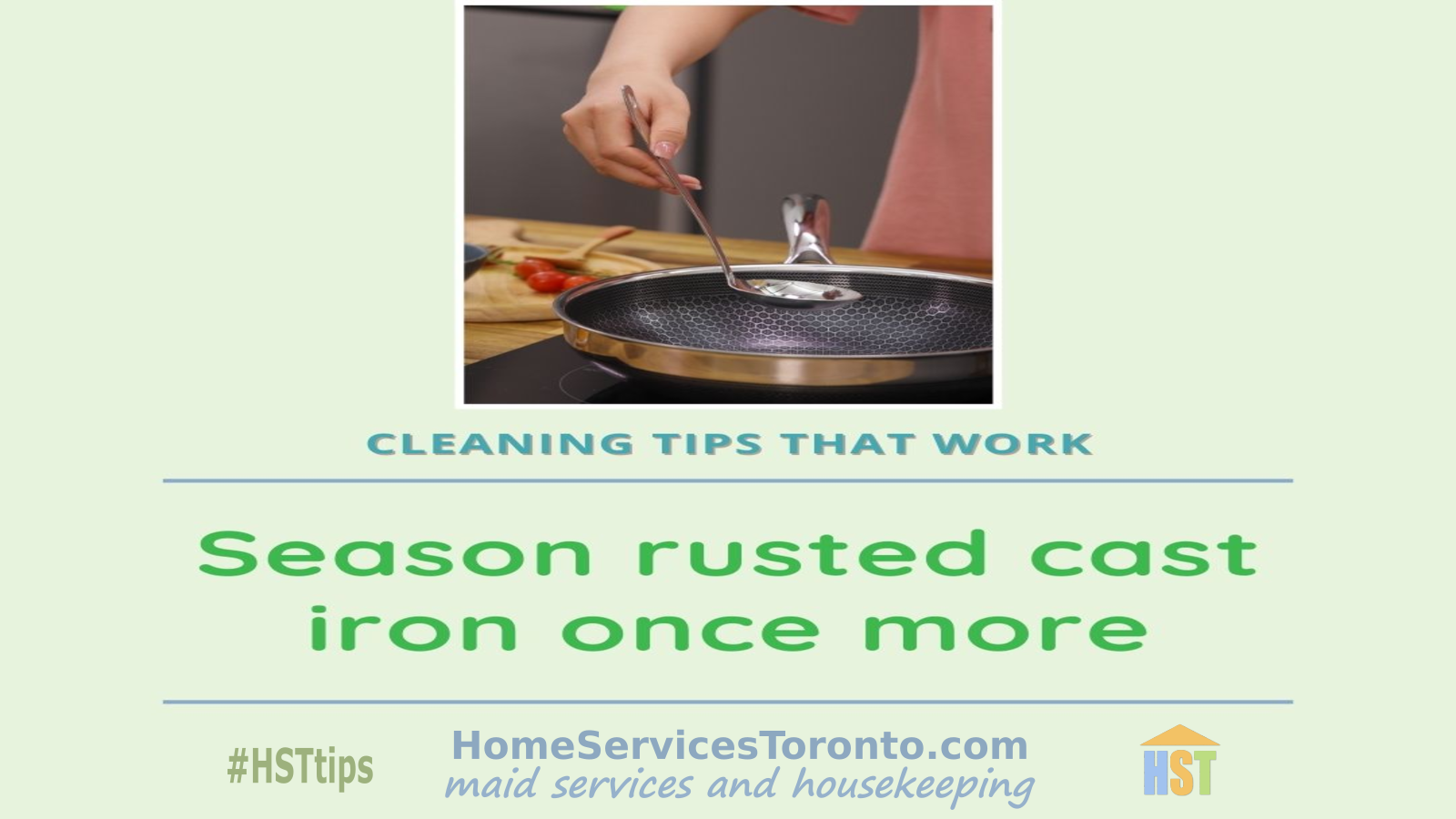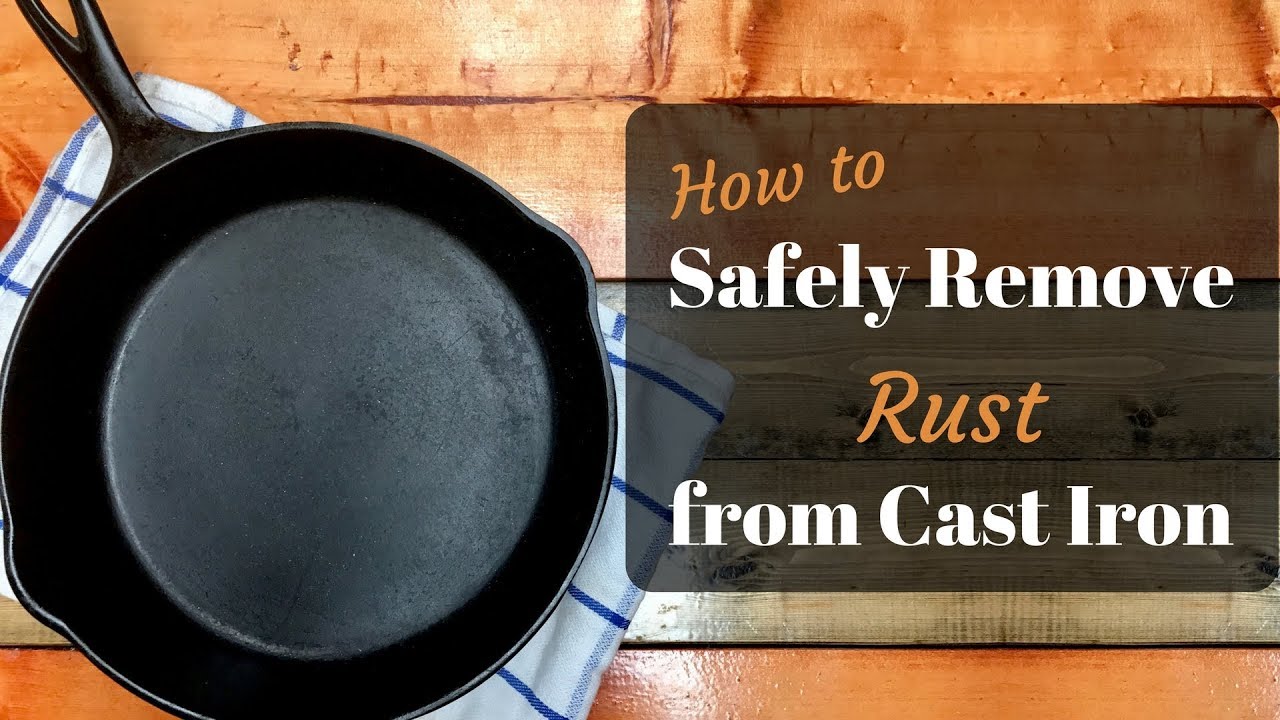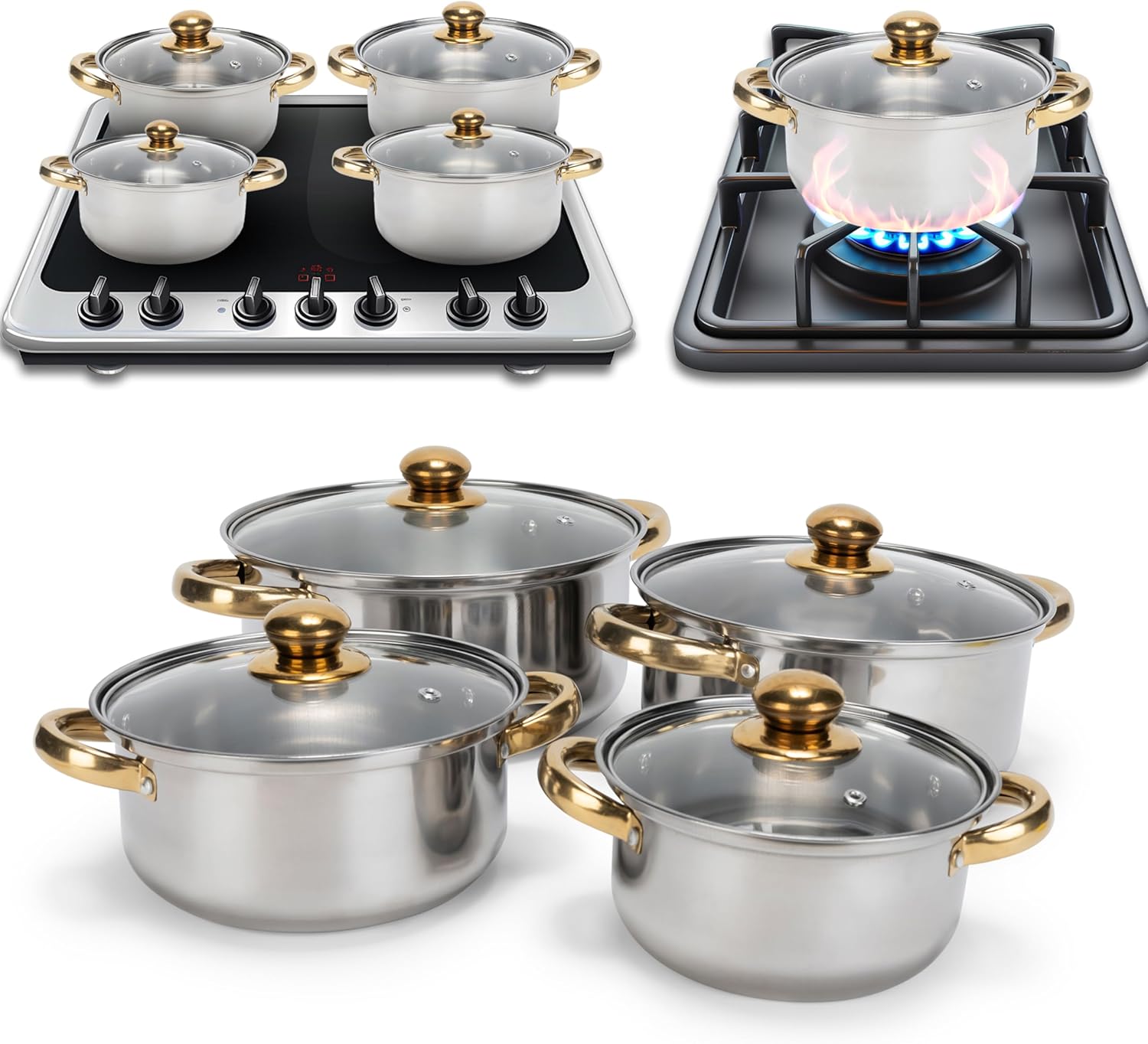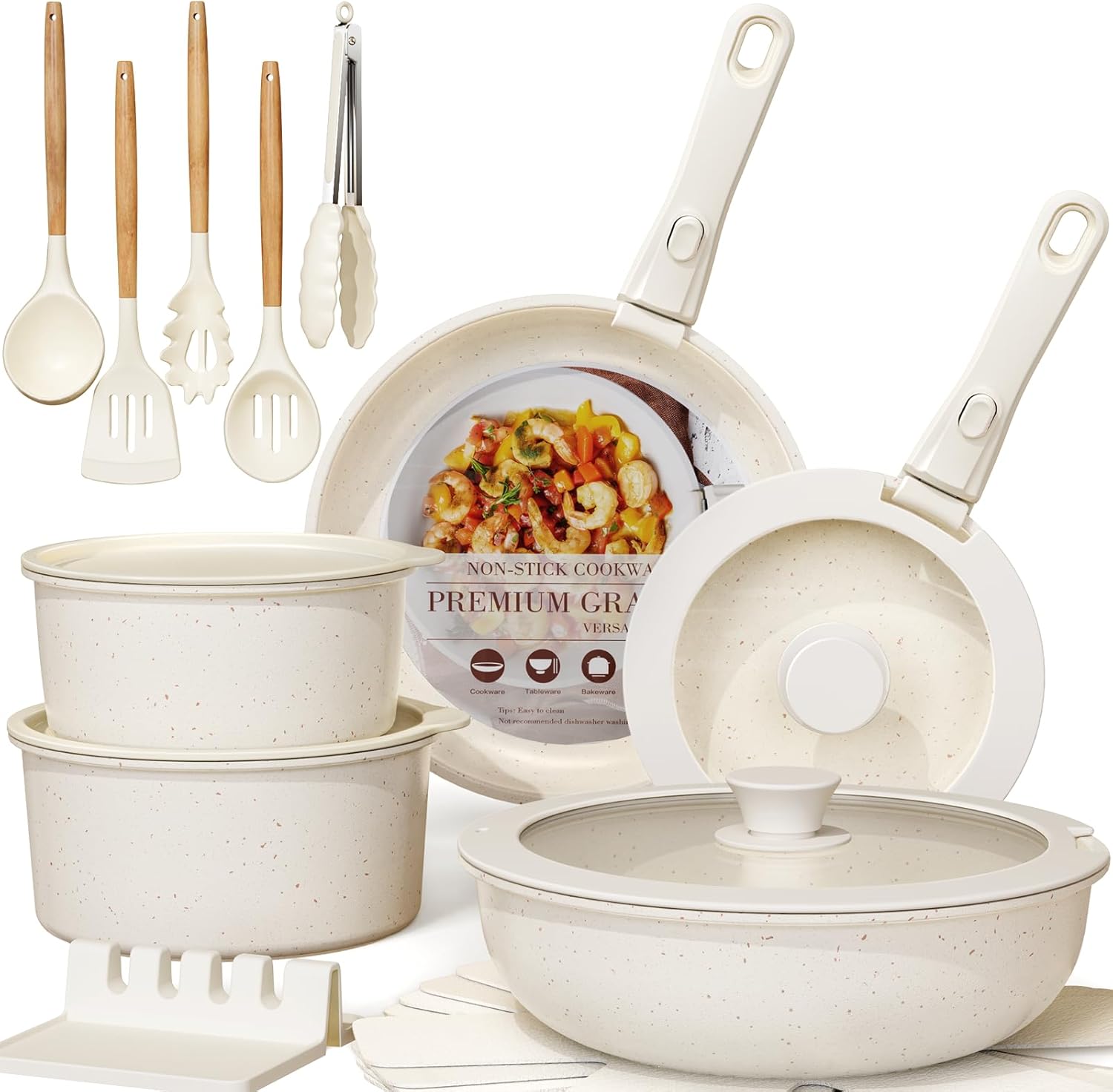To restore rusted cast iron cookware, start by scrubbing off rust with steel wool and warm, soapy water. Rinse, dry thoroughly, and re-season the pan with oil.
Restoring Rusted Cast Iron Cookware Guide:Cast iron cookware is a cherished kitchen staple, known for its durability and heat retention. Over time, rust can develop, making your favorite skillet less effective and appealing. Fortunately, restoring rusted cast iron is simple and rewarding. This guide will walk you through the essential steps to rejuvenate your cookware, ensuring it remains a reliable partner in your culinary adventures.
With just a few tools and some effort, you can bring your cast iron back to life, ready for everything from frying eggs to baking cornbread. Embrace the art of restoration and enjoy your cookware for years to come.

Credit: www.homeservicestoronto.com
The Charm Of Cast Iron Cookware
Cast iron cookware has a unique charm that captivates many. It combines practicality with beauty. Each piece tells a story. The rich history makes it special. Many chefs and home cooks prefer cast iron.
Timeless Kitchen Staple
Cast iron cookware has stood the test of time. Here are some reasons why:
- Durability: Cast iron lasts for generations.
- Heat Retention: It keeps food warm longer.
- Non-stick Surface: With proper seasoning, it becomes non-stick.
- Versatility: Suitable for stovetop and oven use.
This cookware ages beautifully. It develops a natural patina over time. Many love the rustic look it brings to kitchens.
Culinary Versatility
Cast iron pans are incredibly versatile. They can handle various cooking methods:
| Cooking Method | Best Use |
|---|---|
| Searing | Perfect for meats and vegetables. |
| Baking | Great for cornbread and pizzas. |
| Frying | Ideal for fried chicken and donuts. |
| Slow Cooking | Excellent for stews and casseroles. |
Cast iron cookware can handle high heat. It’s perfect for both indoor and outdoor cooking. Whether grilling or baking, it excels in every task. Every dish cooked in cast iron tastes better.
Recognizing Rust: Identifying The Issues
Recognizing rust on cast iron cookware is essential. Early detection helps you restore your favorite pans. Knowing what to look for makes this task easier.
Visual Inspection
Start with a thorough visual inspection. Look for these signs of rust:
- Red or orange spots: These indicate rust formation.
- Flaking or peeling: This shows deterioration.
- Rough texture: A smooth surface should be present.
Use a flashlight for better visibility. Inspect the bottom, sides, and handle. Don’t forget to check inside the cookware.
Impact On Cooking
Rust affects cooking performance significantly. Here are some key impacts:
| Issue | Effect |
|---|---|
| Food Flavor: | Rust can alter the taste of your food. |
| Food Safety: | Rust may introduce harmful particles. |
| Heat Distribution: | Rust affects how heat spreads in the pan. |
Address rust issues quickly to maintain cooking quality. Restore your cookware to enjoy its full benefits.
Preparation For Restoration
Restoring rusted cast iron cookware requires careful preparation. Gathering the right tools and ensuring safety are vital steps. Proper preparation will make the restoration process smooth and effective.
Gathering Necessary Tools
Collect the following tools before starting your restoration:
- Steel wool or a wire brush
- Sandpaper (medium and fine grit)
- Vegetable oil or shortening for seasoning
- Soap (mild, non-abrasive)
- Bucket or large container
- Rubber gloves for protection
- Old rags or paper towels
- Oven for seasoning
Safety Measures
Safety is crucial during restoration. Follow these measures:
- Wear rubber gloves to protect your hands.
- Work in a well-ventilated area.
- Use goggles to shield your eyes from dust.
- Keep children and pets away from the workspace.
- Dispose of rust and debris properly.
Preparing well will ensure a successful restoration. Take your time to gather tools and prioritize safety.

Credit: www.youtube.com
Stripping Down: Removing Rust
Rust can ruin your beloved cast iron cookware. Removing it properly restores your pans. Follow these methods to strip down rust effectively.
Manual Scrubbing Techniques
Manual scrubbing is a simple method. Use these steps for effective rust removal:
- Gather Supplies: You need:
- Steel wool or a scrub pad
- Dish soap
- Water
- A bucket or sink
- Dry cloth
- Soak the Cookware: Fill a bucket with warm, soapy water.
- Scrub the Rust: Use steel wool to scrub affected areas.
- Rinse and Dry: Rinse with clean water and dry immediately.
This method is effective for light to moderate rust. It allows you to control the pressure applied.
Chemical Rust Removers
Chemical rust removers work on tough rust stains. Choose a product designed for cast iron. Here’s how to use them:
| Step | Action |
|---|---|
| 1 | Read the instructions carefully. |
| 2 | Apply the rust remover to the affected area. |
| 3 | Let it sit for the recommended time. |
| 4 | Scrub with a brush or pad. |
| 5 | Rinse thoroughly with water. |
| 6 | Dry completely with a cloth. |
Always wear gloves and work in a ventilated area. Chemical rust removers can be harsh but effective.
Seasoning: The Secret To Non-stick
Seasoning cast iron cookware creates a natural non-stick surface. This process involves applying oil and heating the pan. Over time, seasoning builds up and enhances cooking performance.
Choosing The Right Oil
Not all oils are suitable for seasoning. Select oils with high smoke points. Here are some good options:
- Flaxseed Oil: High smoke point and creates a hard finish.
- Canola Oil: Affordable and effective for seasoning.
- Coconut Oil: Adds flavor and works well with high heat.
- Grapeseed Oil: Neutral taste with a high smoke point.
Avoid using butter or olive oil. They have low smoke points and can create sticky residues.
The Seasoning Process
- Clean: Remove rust or debris using a scrubber.
- Dry: Wipe the cookware dry to prevent moisture.
- Apply Oil: Use a cloth to spread a thin layer of oil.
- Heat: Place the pan upside down in an oven at 450°F (232°C).
- Bake: Leave it for 1 hour to allow proper seasoning.
- Cool: Turn off the oven and let the pan cool inside.
Repeat this process several times. This builds layers of seasoning. A well-seasoned pan becomes non-stick and easy to clean.
:max_bytes(150000):strip_icc()/__opt__aboutcom__coeus__resources__content_migration__serious_eats__seriouseats.com__images__2016__09__20160817-cast-iron-pan-vicky-wasik-1-2-5ca3f25cf17a4a6aa97f4a8c878c63b3.jpg)
Credit: www.seriouseats.com
Curing The Cookware
Curing your cast iron cookware is essential. This process builds a natural non-stick surface. It protects against rust and enhances flavors in your food. Follow these methods for effective curing.
Oven Curing Method
The oven curing method is simple and effective. Here’s how to do it:
- Preheat your oven to 375°F (190°C).
- Clean your cookware thoroughly. Use hot, soapy water and a scrubber.
- Dry your cookware completely. Water can cause rust.
- Apply a thin layer of oil. Use vegetable oil or flaxseed oil.
- Place the cookware upside down in the oven.
- Put a baking sheet below to catch drips.
- Bake for one hour.
- Turn off the oven and let it cool inside.
This method creates a strong, durable seasoning layer. Repeat it a few times for better results.
Alternative Curing Methods
If you prefer other methods, consider these options:
- Stovetop Curing: Heat your pan on medium heat. Add oil and spread it evenly. Let it heat for about 10 minutes.
- Grill Curing: Preheat your grill. Apply oil and place the cookware on the grill. Close the lid and let it cure for 30 minutes.
- Fire Curing: Use a campfire or outdoor grill. Hold the cookware over the flames. Rotate it to cure evenly.
Each method offers unique benefits. Choose the one that fits your style.
Maintenance: Keeping The Shine
Proper maintenance ensures your cast iron cookware remains functional and beautiful. Regular care prevents rust and keeps the surface smooth. Follow these tips to maintain your prized pieces.
Regular Cleaning Routine
Cleaning cast iron is simple. Follow these steps for a sparkling finish:
- Use hot water and a stiff brush to scrub.
- Avoid soap, as it can strip the seasoning.
- For tough spots, use kosher salt as a scrubber.
- Rinse thoroughly and dry immediately to prevent rust.
- Apply a thin layer of oil to restore shine.
Use these cleaning tools for best results:
- Stiff brush
- Kosher salt
- Paper towels
- Vegetable oil or flaxseed oil
Storing Your Cast Iron
Proper storage keeps your cookware in top shape. Follow these guidelines:
| Storage Tips | Why It Matters |
|---|---|
| Store in a dry place | Prevents moisture and rust |
| Use a paper towel between pans | Protects the seasoning |
| Avoid stacking heavy items | Prevents damage |
| Check for rust regularly | Catch issues early |
Following these steps keeps your cast iron cookware shiny and ready for use. Enjoy cooking with your restored treasures!
Troubleshooting Common Issues
Restoring rusted cast iron cookware can be tricky. Many face issues during this process. Understanding these problems helps achieve better results. This section covers common problems and their solutions.
Preventing Future Rust
To keep your cast iron cookware in great shape, follow these tips:
- Keep it dry: Moisture causes rust. Always dry your cookware after washing.
- Store properly: Store cast iron in a dry place. Avoid stacking with other cookware.
- Use a light coat of oil: Apply a thin layer of oil. This protects the surface.
- Avoid acidic foods: Foods like tomatoes can damage seasoning. Use them sparingly.
Regular maintenance prevents rust from forming again.
Restoring Damaged Seasoning
Sometimes, seasoning gets damaged during use. Here’s how to restore it:
- Clean the pan: Use a scrub brush and hot water. Remove any rust and food residue.
- Dry thoroughly: Wipe it down with a cloth. Ensure no moisture remains.
- Apply oil: Use flaxseed or vegetable oil. Coat the entire surface lightly.
- Heat it up: Place the pan upside down in the oven. Bake at 450°F (232°C) for an hour.
- Let it cool: Turn off the oven and let the pan cool inside.
This process helps to rebuild the seasoning layer effectively.
| Step | Action |
|---|---|
| 1 | Clean the pan |
| 2 | Dry thoroughly |
| 3 | Apply oil |
| 4 | Heat it up |
| 5 | Let it cool |
Following these steps restores your cookware to its best condition.
Cooking With Restored Cast Iron
Restored cast iron cookware offers unique cooking benefits. It enhances flavor and improves the longevity of your kitchen tools. Using this cookware elevates your cooking experience.
Enhancing Flavor
Cast iron cookware is renowned for its ability to enhance flavors. Here’s how:
- Heat Retention: Cast iron holds heat well. It cooks food evenly.
- Seasoned Surface: The seasoning creates a natural non-stick layer. This layer adds depth to the flavors.
- Versatility: Use it on the stovetop or in the oven. Perfect for sautéing, frying, or baking.
Many chefs prefer cast iron for its ability to create a perfect sear. It brings out the best in meats and vegetables.
Cookware Longevity
Restoring cast iron cookware extends its lifespan. Here are key points:
| Benefit | Description |
|---|---|
| Durability | Cast iron can last for generations with care. |
| Repairable | Rust can be removed and seasoning reapplied. |
| Eco-Friendly | Reduces waste by keeping cookware in use. |
Taking care of your cast iron means fewer replacements. It saves money and resources over time.
By cooking with restored cast iron, you embrace tradition. You enjoy delicious meals that are healthier and tastier.
Eco-friendly Aspect Of Restoration
Restoring rusted cast iron cookware is not just practical. It is also an eco-friendly choice. Instead of throwing away old pots and pans, you can give them new life. This process reduces waste and promotes sustainability.
Sustainability Of Cast Iron
Cast iron cookware is durable and long-lasting. It can last for generations with proper care. Choosing cast iron over disposable cookware reduces environmental impact.
- Minimal use of resources: Cast iron requires fewer materials than non-stick pans.
- Long lifespan: A well-maintained cast iron skillet can last a lifetime.
- Recyclable: At the end of its life, cast iron can be recycled.
Avoiding Waste With Restoration
Restoration prevents waste by keeping items out of landfills. Every restored piece has a story and history.
- Clean the rust: Use a steel wool pad or vinegar.
- Season the cookware: Apply a thin layer of oil.
- Heat it: Bake the cookware to create a non-stick surface.
Restoring cookware saves money too. Instead of buying new, use what you have. This choice supports a healthier planet.
| Benefit | Description |
|---|---|
| Waste Reduction | Less trash in landfills leads to a cleaner environment. |
| Resource Conservation | Using existing cookware saves materials and energy. |
| Economic Savings | Restoration is cheaper than buying new cookware. |
Embrace the eco-friendly aspect of restoration. Choose to repair and reuse. Your planet will thank you.
Frequently Asked Questions
Can A Rusty Cast-iron Pan Be Restored?
Yes, a rusty cast-iron pan can be restored. Start by scrubbing off rust with steel wool or a wire brush. Rinse, dry, and apply a thin layer of oil. Heat the pan to season it. Regular maintenance prevents future rust.
Enjoy cooking with your restored pan!
How Do You Remove Rust From Cast Iron Cookware?
To remove rust from cast iron cookware, scrub the affected areas with a steel wool pad. Rinse with warm water and dry immediately. Apply a thin layer of vegetable oil to prevent future rust. For heavy rust, consider using a mixture of vinegar and baking soda.
How Do I Make My Cast-iron Pan Look New Again?
To restore your cast-iron pan, scrub it with a mixture of coarse salt and water. Rinse and dry thoroughly. Apply a thin layer of vegetable oil, then bake it upside down in the oven at 350°F for an hour. This process will revive its non-stick surface and shine.
Does Wd-40 Remove Rust Cast Iron?
WD-40 can help remove rust from cast iron. Spray it on the affected area and let it sit for a few minutes. Use a wire brush or cloth to scrub away the rust. Repeat if necessary for stubborn spots. Always clean and dry the surface afterward to prevent future rust.
Conclusion
Restoring rusted cast iron cookware is a rewarding process. With patience and the right techniques, you can bring your cookware back to life. A well-maintained skillet enhances cooking quality and longevity. Remember to season regularly for the best results. Enjoy the benefits of your revitalized cast iron for years to come!





Leave a Reply